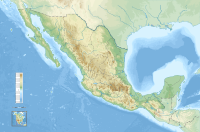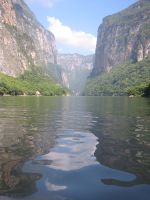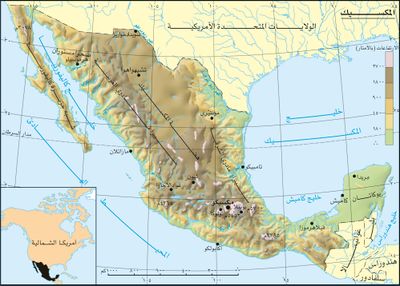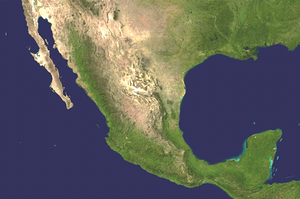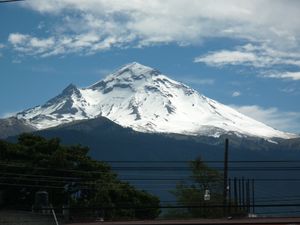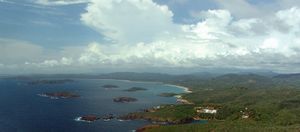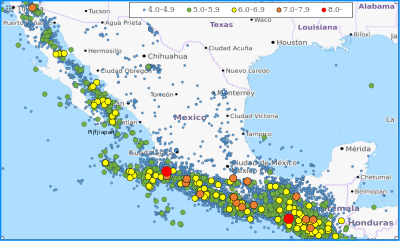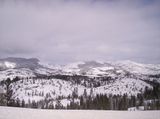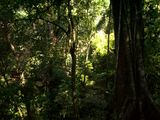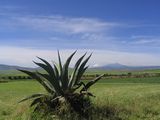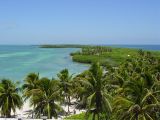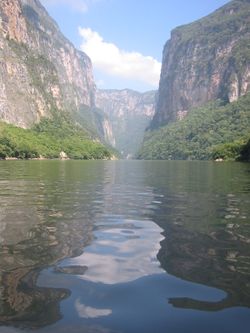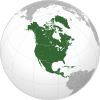جغرافيا المكسيك
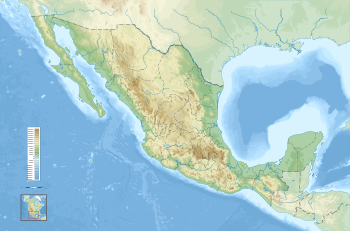 | |
| القارة | أمريكا الشمالية |
|---|---|
| الإحداثيات | 23°00′N 102°00′W / 23.000°N 102.000°W |
| المساحة | |
| • الإجمالية | 1،972،550 km2 (761،610 sq mi) |
| • أرض | 98.96% |
| • مياه | 1.04% |
| الخط الساحلي | 9،330 km (5،800 mi) |
| الحدود | طول الحدود البرية 4,263 كم |
| أعلى نقطة | بركان پيكو دى أوريزابا 5,700 م |
| أوطى نقطة | لاگونا سالادا -10 م |
| أطول نهر | ريو گراندي 3,108 كم |
| أكبر بحيرة | بحيرة تشاپالا 1,100 كم² |
جغرافيا المكسيك تصف السمات الجغرافية للمكسيك، البلد الواقع في الأمريكتين. تقع المسكيك تقريباً عند 23° N و 102° W[1] في الجزء الجنوبي من أمريكا الشمالية.[2][3] من أقصى النقاط الأرضية، يبلغ طول المكسيك ما يربو على 3,200 كم. ويحد المكسيك من الشمال الولايات المتحدة (تحديداً، من الغرب إلى الشرق، كاليفورنيا، أريزونا، ونيومكسيكو وتكساس)، وإلى الغرب والجنوب المحيط الهادي، وإلى الشرق خليج المكسيك، وإلى الجنوب الشرقي بليز وگواتيمالا والبحر الكاريبي. وهي المكون الأقصى شمالاً من أمريكا اللاتينية، وهي الأكبر تعداداً Spanish-speaking country in the world. Mexico is the world's 13th largest country, three times the size of Texas.[4]
Almost all of Mexico is on the North American Plate, with small parts of the Baja California Peninsula in the northwest on the Pacific and Cocos Plates. Some geographers include the portion east of the Isthmus of Tehuantepec including the Yucatán Peninsula within North America. This portion includes Campeche, Chiapas, Tabasco, Quintana Roo, and Yucatán, representing 12.1 percent of the country's total area. Alternatively, the Trans-Mexican Volcanic Belt may be said to delimit the region physiographically on the north.[5] Geopolitically, Mexico is generally not considered part of Central America. Politically, Mexico is divided into thirty-one states and a federal district, which serves as the national capital.
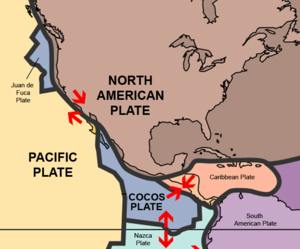
As well as numerous neighbouring islands, Mexican territory includes the more remote Isla Guadalupe and the Islas Revillagigedo in the Pacific. Mexico's total area covers 1,972,550 square kilometers, including approximately 6,000 square kilometers of islands in the Pacific Ocean, Gulf of Mexico, Caribbean Sea, and Gulf of California. On its north, Mexico shares a 5,000-kilometer border with the United States. The meandering Río Bravo del Norte (known as the Rio Grande in the United States) defines the border from Ciudad Juárez east to the Gulf of Mexico. A series of natural and artificial markers delineate the United States-Mexican border west from Ciudad Juárez to the Pacific Ocean. The Mexico-U.S. boundary is jointly administered by the International Boundary and Water Commission.[6] On its south, Mexico shares an 871 kilometer border with Guatemala and a 251-kilometer border with Belize.
Mexico has a 9,330 kilometer coastline, of which 7,338 kilometers face the Pacific Ocean and the Gulf of California, and the remaining 2,805 kilometers front the Gulf of Mexico and the Caribbean Sea. Mexico's exclusive economic zone (EEZ) covers 3،269،386 km2 (1،262،317 sq mi) and is the 13th largest in the world. It extends 200 mi (320 km) nautical miles off each coast. The landmass of Mexico dramatically narrows as it moves in a southeasterly direction from the United States border and then abruptly curves northward before ending in the 500-kilometer-long Yucatán Peninsula. Indeed, the state capital of Yucatán, Mérida, is farther north than Mexico City or Guadalajara.

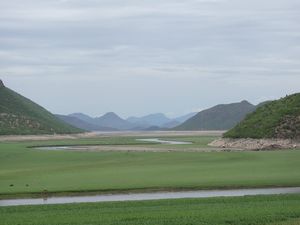
الموقع
تقريبا كل المكسيك تقع في صفيحة أمريكا الشمالية، باستثناء أجزاء صغيرة من شبه جزيرة منخفض كاليفورنيا التي تقع في صفيحتي المحيط الهادي وجزر كوكس. جيوفيزيائيًا، يضم بعض الجغرافيين إقليم شرق برزخ تيهوانتبيك (حوالي 12 ٪ من المجموع) إلي أمريكا الوسطى. ولكن من الناحية الجغرافية السياسية، فإن المكسيك تعتبر جزءا من أمريكا الشمالية بالكامل، إلى جانب كندا والولايات المتحدة.
المساحة
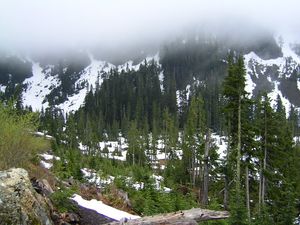
المكسيك مساحتها الإجمالية 1.972.550 كيلومتر مربع، مما يجعلها الدولة الرابعة عشر من حيث مجموع المساحة، وتضم ما يقرب من 6,000 كيلومتر مربع من الجزر في المحيط الهادي (بما في ذلك جزيرة گوادالوپه وجزر ريفيلاگيجيدو النائية) وخليج المكسيك وبحر الكاريبي، وخليج كاليفورنيا. وفي الشمال، المكسيك، تشترك مع الولايات المتحدة في حدود تبلغ 3،141 كيلومتر. تعرجات ريو برافو ديل نورت (المعروفة باسم ريو گرانده في الولايات المتحدة) تعرف الحدود من مدينة سيوداد خواريز شرقًا لخليج المكسيك. وسلسلة من العلامات الطبيعية والاصطناعية ترسم الحدود بين المكسيك والولايات المتحدة غرب سيوداد خواريز، إلى المحيط الهادئ. وفي الجنوب، المكسيك تشترك في 871 كيلومتر من الحدود مع گواتيمالا ولها حدود تبلغ 251 كيلومترا مع بليز.
الجبال
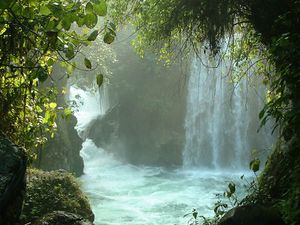
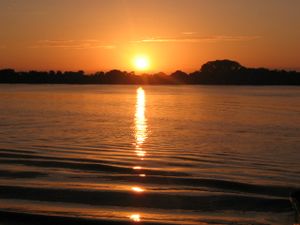
ثلثي مساحتها تغطيها سلاسل جبلية شاهقة، وهضاب متموجة، كما يوجد بها غابات مدارية وصحار جافة، وسهول أودية خصبة. فالمكسيك عبارة عن هضبة مرتفعة ضخمة تحيط بها السلاسل الجبلية التي تنحدر بشدة إلى سهول ساحلية ضيقة في الغرب والشرق، وتتلاقى سلسلتا جبال سيرا مادري الغربية وسيرا مادري الشرقية في منطقة تسمى لاجونت في الجنوب الشرقي حيث تكون السلسلتان سيرامادرا دلسور وهي مجموعة من الجبال البركانية المتداخلة تضم أعلى قمم المكسيك، وتؤدي سيرامادرادلسور إلى إيستموس في تيوانتيبك والتي تقع بين خليج كمبتشي وخليج تيوانتيبك، وتعتبر الهضبة الوسطى من أهم معالم الدولة الجغرافية والتي تعتبر امتداد لسهول الولايات المتحدة الجنوب غربية، وتشكل أكثر من نصف المساحة الإجمالية للمكسيك وتنحدر لأسفل من الغرب نحو الشرق ومن الشمال إلى الجنوب، وتضم الهضبة واديين واسعين يمثلان انخفاضا ملحوظا فيها وهما "بولسن دي مابيمو" في الشمال ووادي المكسيك أو انتوال في وسط المكسيك، أما السهول الساحلية فهي عموما منخفضة - مسطحة ورملية على الرغم من أن ساحل المحيط الهادي أحيانا ما تقطعه نتوءات جبلية، وتمتد شبه جزيرة كاليفورنيا التي تتميز بالطول والضيق لحوالي "760 ميل" جنوبا من الجزء الشمال غربي من الدولة وتقطعها بعض الجبال التي تعتبر امتدادا لسلسلة الجبال الساحلية في ولاية كاليفورنيا الأمريكية، وبالنسبة لشبه جزيرة يوكاتان والتي تشكل أعلى الجزء الجنوب شرقي من الدولة - منخفضة ومسطحة.
الأنهار
وتضم المكسيك عددا قليلا من الأنهار الرئيسية ومعظمها غير صالح للملاحة، ويعد نهر جراندي والذي يعرف في المكسيك أيضا باسم ريوبرافو ديل نورت من أطول الأنهار، ومن الأنهار الأخرى بالساس، جريجالفا، أوسوماسينتا، في الجنوب وكونشوس في الشمال. وتعتبر بحيرة "شابالا" في الغرب من أكبر مصادر المياه الداخلية، ويضم وادي المكسيك عددا من البحيرات الضحلة.
النشاط السيزمي
Situated atop three of the large tectonic plates that constitute the Earth's surface, Mexico is one of the most seismologically active regions on earth.[7] The motion of these plates causes earthquakes and volcanic activity.
المناخ
مدار السرطان effectively divides the country into temperate and tropical zones. Land north of the twenty-fourth parallel experiences cooler temperatures during the winter months. South of the twenty-fourth parallel, temperatures are fairly constant year round and vary solely as a function of elevation.
Areas south of the twentieth-fourth parallel with elevations up to 1،000 متر (3،281 ft) (the southern parts of both coastal plains as well as the Yucatán Peninsula), have a yearly median temperature between 24 و 28 °C (75.2 و 82.4 °F). Temperatures here remain high throughout the year, with only a 5 °C (9 °F) difference between winter and summer median temperatures. Although low-lying areas north of the twentieth-fourth parallel are hot and humid during the summer, they generally have lower yearly temperature averages (from 20 إلى 24 °C أو 68.0 إلى 75.2 °F) because of more moderate conditions during the winter.
Between 1،000 و 2،000 متر (3،281 و 6،562 ft), one encounters yearly average temperatures between 16 و 20 °C (60.8 و 68.0 °F). Towns and cities at this elevation south of the twenty-fourth parallel have relatively constant, pleasant temperatures throughout the year, whereas more northerly locations experience sizeable seasonal variations. Above 2،000 متر (6،562 ft), temperatures drop as low as an average yearly range between 8 و 12 °C (46.4 و 53.6 °F) in the Cordillera Neovolcánica. At 2،300 متر (7،546 ft), Mexico City has a yearly median temperature of 15 °C (59 °F) with pleasant summers and mild winters. Average daily highs and lows for May, the warmest month, are 26 و 12 °C (78.8 و 53.6 °F), and average daily highs and lows for January, the coldest month, are 19 و 6 °C (66.2 و 42.8 °F).
Rainfall varies widely both by location and season. Arid or semiarid conditions are encountered in the Baja California Peninsula, the northwestern state of Sonora, the northern altiplano, and also significant portions of the southern altiplano. Rainfall in these regions averages between 300 و 600 ميليمتر (11.8 و 23.6 in) per year, although even less in some areas, particularly in the state of Baja California. Average rainfall totals are between 600 و 1،000 ميليمتر (23.6 و 39.4 in) in most of the major populated areas of the southern altiplano, including Mexico City and Guadalajara. Low-lying areas along the Gulf of Mexico receive in excess of 1،000 ميليمتر (39.4 in) of rainfall in an average year, with the wettest region being the southeastern state of Tabasco, which typically receives approximately 2،000 ميليمتر (78.7 in) of rainfall on an annual basis. Parts of the northern altiplano, highlands and high peaks in the Sierra Madres receive yearly snowfall. Citlaltépetl, Popocatépetl and Iztaccíhuatl continue to support glaciers, the largest of which is the Gran Glaciar Norte.
Mexico has pronounced wet and dry seasons. Most of the country experiences a rainy season from June to mid-October and significantly less rain during the remainder of the year. February and July generally are the driest and wettest months, respectively. Mexico City, for example, receives an average of only 5 ميليمتر (0.2 in) of rain during February but more than 160 ميليمتر (6.3 in) in July. Coastal areas, especially those along the Gulf of Mexico, experience the largest amounts of rain in September. Tabasco typically records more than 300 ميليمتر (11.8 in) of rain during that month. A small coastal area of northwestern coastal Mexico around Tijuana has a Mediterranean climate with considerable coastal fog and a rainy season that occurs in winter.
Mexico lies squarely within the hurricane belt, and all regions of both coasts are susceptible to these storms from June through November. Hurricanes on the Pacific coast are often less violent than those affecting Mexico's eastern coastline. Several hurricanes per year strike the Caribbean and Gulf of Mexico coastline, however, and these storms bring high winds, heavy rain, extensive damage, and occasional loss of life. Hurricane Gilbert passed directly over Cancún in September 1988, with winds in excess of 200 كيلومترات في الساعة (124 mph), producing major damage to hotels in the resort area. It then struck northeast Mexico, where flooding from the heavy rain killed dozens in the Monterrey area and caused extensive damage to livestock and vegetable crops.
التنوع الحيوي


المكسيك هي واحدة من البلدان الثمانية عشر الشديدة التباين في العالم. بأكثر من 200،000 نوع مختلف، يستوطن المكسيك 10-12 ٪ من التنوع البيولوجي في العالم.المكسيك تحتل المرتبة الأولى في مجال التنوع البيولوجي في الزواحف حيث تحتوي على 707 مع الأنواع المعروفة، والمرتبة الثانية محتويةً على 438 نوعا من الثدييات، والرابعة في البرمائيات محتويةً على 290 من الأنواع، والرابعة في النباتات، محتويةً على 26،000 من الأنواع المختلفة.المكسيك أيضًا تعتبر ثاني دولة في العالم في النظام الإيكولوجي والرابعة في الأنواع عموما.وهناك حوالي 2،500 من الأنواع المحمية بموجب التشريعات المكسيكية.
ازالة الغابات
الحكومة المكسيكية أنشأت النظام الوطني للمعلومات عن التنوع البيولوجي، من أجل دراسة وترويج الاستعمال المستدام للنظم الإيكولوجية. إزالة الغابات هي واحدة من أخطر قضايا البيئة في المكسيك، حيث تفقد أكثر من مليون هكتار من الغابات كل سنة. اعتبارًا من عام 2002، كان للمكسيك ثاني أسرع معدل لإزالة الغابات في العالم، في المرتبة الثانية بعد البرازيل.
الطبيعة
في المكسيك، هناك 170،000 كيلومترا مربعا تعتبر "محميات طبيعية". وتشمل هذه المحميات 34 محيطات حيوية محفوظة (نظم إيكولوجية لم تتغير)، 64 متنزهًا وطنيًا، 4 معالم طبيعية (محمية إلى الأبد لقيمتها الجمالية أو العلمية أو التاريخية)، و 26 مناطق محمية من النباتات والحيوانات، و 4 مناطق لحماية الموارد الطبيعية (حفظ التربة، الأحواض المائية والغابات) و 17 ملاذات (مناطق غنية بالأنواع المختلفة).
مؤشرات عامة
المناخ: varies from tropical to desert.
البسيطة: high, rugged mountains; low coastal plains; high plateaus; desert.
المناسيب القصوى:
- lowest point: Laguna Salada -10 m
- highest point: Pico de Orizaba volcano 5,700 m
Natural resources: petroleum, silver, copper, gold, lead, zinc, natural gas and timber.
استخدامات الأراضي:
- arable land: 12.98%
- permanent crops: 1.36%
- other: 85.66% (2011)
Irrigated land: 64,600 كم² (2009)
Total renewable water resources: 457.2 km3
Natural hazards: Tsunamis and tropical cyclones along the Pacific coast, volcanoes and destructive earthquakes in the center and south, and hurricanes on the Gulf of Mexico and Caribbean coasts.
volcanism: volcanic activity in the central-southern part of the country; the volcanoes in Baja California are mostly dormant; Colima (elev. 3,850 m), which erupted in 2010, is Mexico's most active volcano and is responsible for causing periodic evacuations of nearby villagers; it has been deemed a "Decade Volcano" by the International Association of Volcanology and Chemistry of the Earth's Interior, worthy of study due to its explosive history and close proximity to human populations; Popocatepetl (elev. 5,426 m) poses a threat to Mexico City; other historically active volcanoes include Barcena, Ceboruco, El Chichon, Michoacan-Guanajuato, Pico de Orizaba, San Martin, Socorro, and Tacana
Environment – current issues: Natural fresh water resources scarce and polluted in north, inaccessible and poor quality in center and extreme southeast; raw sewage and industrial effluents polluting rivers in urban areas; deforestation; widespread erosion; desertification; serious air pollution in the national capital and urban centers along the US-Mexico border; land subsudence in Valley of Mexico caused by groundwater delpletion.
Environment – international agreements: Party to: Biodiversity, Climate Change, Climate Change-Kyoto Protocol, Desertification, Endangered Species, Hazardous Wastes, Law of the Sea, Marine Dumping, Marine Life Conservation, Ozone Layer Protection, Ship Pollution, Wetlands, Whaling.
انظر أيضاً
المراجع
- ^ Francaviglia, Richard V. "Geography and climate", U.S. Mexican War, 1846–1848. March 14, 2006: PBS / KERA
- ^ Mexico The American Heritage Reference Collection Archived 2007-02-24 at the Wayback Machine, et al.
- ^ Mexico Archived 2007-06-20 at the Wayback Machine The Columbia Encyclopedia Archived فبراير 2, 2007 at the Wayback Machine
- ^ "Mexico Country Specific Information Archived ديسمبر 16, 2010 at the Wayback Machine." United States Department of State. Retrieved on March 22, 2012.
- ^ Nord-Amèrica, in Gran Enciclopèdia Catalana
- ^ Robert J. McCarthy, Executive Authority, Adaptive Treaty Interpretation, and the International Boundary and Water Commission, U.S.-Mexico, 14-2 U. Denv. Water L. Rev. 197(Spring 2011) (also available for free download at http://papers.ssrn.com/sol3/papers.cfm?abstract_id=1839903).
- ^ Rhea, Harley M. Benz, Matthew Herman, Arthur C. Tarr, Gavin P. Hayes, Kevin P. Furlong, Antonio Villaseñor, Richard L. Dart, Susan. "USGS Open-File Report 2010-1083-F: Seismicity of the Earth 1900–2010 Mexico and Vicinity". pubs.usgs.gov. Retrieved 22 March 2018.
{{cite web}}: CS1 maint: multiple names: authors list (link)
- This article contains material from the Library of Congress Country Studies, which are United States government publications in the public domain.
 This article contains material from the CIA World Factbook which, as a U.S. government publication, is in the المشاع.
This article contains material from the CIA World Factbook which, as a U.S. government publication, is in the المشاع.
- Pages using gadget WikiMiniAtlas
- Coordinates on Wikidata
- Pages using infobox country geography with unknown parameters
- Articles with hatnote templates targeting a nonexistent page
- Portal templates with default image
- مقالات المعرفة المتضمنة نصوصاً من كتاب حقائق العالم
- Pages using country topics with unknown parameters
- جغرافيا المكسيك
- مقالات تحتوي مقاطع ڤيديو
